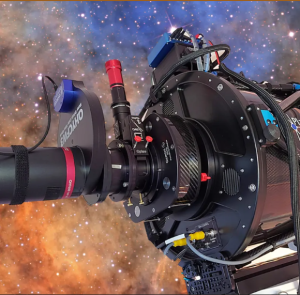The Planewave CDK Reducer – OAG Conversion Kit from Rouz Astro offers a unique “Fast OAG” turnkey solution that is designed to enable the use of an Off-Axis Guider (OAG) in conjunction with the Planewave 0.66x focal reducer to achieve a fast focal ratio, a much wider field of view, and autoguiding. Coupled with an Optec Gemini Focusing Rotator System, precision focus and rotation capability will be added.
 Incorporating an OAG into the system means no more guiding and tracking errors regardless of the sub exposure length, type of mount, imaging train/guidescope flex, lack of encoders, or perfect polar alignment. A much wider field of view is also achieved along with a much faster focal ratio.
Incorporating an OAG into the system means no more guiding and tracking errors regardless of the sub exposure length, type of mount, imaging train/guidescope flex, lack of encoders, or perfect polar alignment. A much wider field of view is also achieved along with a much faster focal ratio.
As the Rouz Astro team notes, “The majority of these CDK telescopes used sensors like the Kodak 16803 which had large 9 micron pixels and sensors. The resulting native image scale of 0.6~0.7 arcseconds/pixel was in the sweet spot for resolution and good signal to noise ratio buildup. With today’s modern low noise CMOS cameras like the Sony IMX571 and IMX455, the smaller 3.76 micron pixels often lead to oversampling at a native image scale of about 0.3″/pixel. Oversampling comes at the cost of requiring a lot more integration time to build up high signal to noise ratio. The resulting image is much brighter than the native one – about 240%. Image resolution is still very high at 0.37~0.46 arcseconds/pixel (depending on CDK model). Since the system will be oversampling in almost all cases, there is no loss in true resolution. A “larger” image of small targets can be produced simply by upsampling the already sharp reducer image.”
They continued, “The field of view (FOV) is limited given the smaller sensors. The dedicated Planewave focal reducer allows smaller sensors to capture a much larger field of view, thus reducing the overall cost associated with large cameras, filters, and filter wheels. Incorporating an OAG into the system means no more guiding and tracking errors regardless of the sub exposure length, type of mount, lack of encoders, or perfect polar alignment.”
How does the Planewave CDK Reducer – OAG Conversion Kit work? As the dedicated Planewave focal reducer only allows 44~47mm of spacing between the reducer and the camera sensor. With mono-cameras that require a filter wheel, there isn’t enough space to add an OAG as well. The Rouz Astro Fast-OAG CDK conversion kit was developed after extensive design and testing with several CDKs and focusers. This configuration positions a large OAG before the Planewave reducer to find guide stars for autoguiding the telescope.
The modification calls for several custom CNC machined adapters that position all the optical and mechanical elements at very specific positions. Extensive testing has been done to compile charts and graphs that allow calculating adapters and spacing that are unique to each Telescope – Focuser – Camera combination. Each system can be designed with custom components and to fit the user’s requirements.
As the Rouz Astro team notes, “As the Each CDK model has specific spacing requirements, one design does not fit all. Custom adapters are designed, CNC machined and anodized. All hardware, adapters, and spacers will be provided. The typical lead time is approximately 3 weeks after the order has been confirmed. The kit is compatible with CDK 12.5, CDK14 and CDK17 Planewave telescopes.
Features of the Planewave CDK Reducer – OAG Conversion Kit include:
– Off-axis guiding
– Fast focal ratio: f/4.5 ~ f/5.25.
– Larger field of view: approximately 1.5 degrees
– High resolution imaging with an image scale of 0.36 ~ 0.47 arcseconds/pixel
– Mono full-frame camera with filter wheel support
– Precision focus and instrument rotation
– Converted back to native in minutes
You can learn more about the kit here.
And to make it easier for you to get the most extensive news, articles and reviews that are only available in the magazine pages of Astronomy Technology Today, we are offering a 1-year magazine subscription for only $6! Or, for an even better deal, we are offering 2 years for only $9. Click here to get these deals which only will be available for a very limited time. You can also check out a free sample issue here.
The Sun is more active than it’s been in years and if that’s not enough, we have the upcoming Total Solar Eclipse on April 8, 2024! If you’d like to learn more about the technology behind solar observing, solar imaging and more, you can check out our new monthly magazine – Solar Astronomy Today. It’s free to read, no subscription needed and available here. And if you are preparing for the upcoming eclipses and want to know your equipment options from solar glasses to the most out of this world solar viewing and imaging options, check out our free publication – The Definitive Guide to Viewing and Imaging the Sun – simply click here and enjoy reading!

